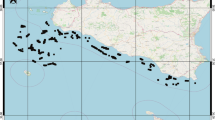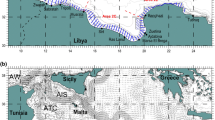Abstract
The article discusses the results of statistical processing of the occurrence of krill individuals depending on some environmental factors, based on actual hydrophysical measurement data acquired at studied stations in the Powell Basin of the Weddell Sea, the Bransfield Strait, and Antarctic Sound, as well as off the South Orkney Islands, in the austral summer of 2022. Data were obtained on the association of the main abiotic environmental factors and their values, which are optimal for juvenile and mature krill individuals, and a number of abiotic environmental factors that affect the distribution of Antarctic krill in the studied region were identified. The results of such statistical modeling are important for monitoring the state of Antarctic ecosystems and their components under changing environmental factors, including current climate change trends.



Similar content being viewed by others
REFERENCES
R. I. Kabakov, R in Action: Analyze and Visualize Data in the Program (DMK Press, Moscow, 2016) [in Russian].
Guidelines for the Collection and Processing of Fishery and Biological Data on Antarctic Aquatic Biological Resources for Russian Scientific Observers in the CCAMLR Convention Area (VNIRO, Moscow, 2014) [in Russian].
Guidelines for the Collection and Primary Processing in the Field of Materials on the Biology and Distribution of Antarctic Krill (VNIRO, Moscow, 1982) [in Russian].
E. G. Morozov, M. V. Flint, A. M. Orlov, et al., “Oceanographic and ecosystem studies in the Atlantic sector of Antarctica (cruise 87 of the research vessel Akademik Mstislav Keldysh),” Oceanology 62 (5), 721–723 (2022). https://doi.org/10.1134/S0001437022050150
V. A. Spiridonov, A. K. Zalota, V. A. Yakovenko, and K. M. Gorbatenko, “Composition of population and transport of juveniles of Antarctic krill in Powell Basin region (northwestern Weddell Sea) in January 2020,” Trudy VNIRO 18, 33–51 (2020).
V. K. Shitikov and S. E. Mastitskii, Classification, regression and other data mining algorithms using R. https://github.com/ranalytics/data-mining. Accessed January 26, 2023.
Scientific Observers Manual (CCAMLR, Hobart, Australia, 2011), pp. 1–232.
D. G. Bitiutskii, E. Z. Samyshev, N. I. Minkina, et al., “Distribution and demography of Antarctic krill and salps in the Atlantic Sector of the Southern Ocean during austral summer 2021–2022,” Water 14, 3812 (2022). https://doi.org/10.3390/w14233812
F. Buchholz, “Moult cycle and growth of Antarctic krill Euphausia superba in the laboratory,” Mar. Ecol. Prog. Ser. 69, 217–229 (1991).
E. L. Cavan, A. Belcher, A. Atkinson, et al., “The importance of Antarctic Krill in biogeochemical cycles,” Nat. Commun. 10, 4742 (2019). https://doi.org/10.1038/s41467-019-12668-7
A. Clarke and P. Tyler, “Adult Antarctic krill feeding at abyssal depths,” Cur. Biol. 28, 282–285 (2008). https://doi.org/10.1016/j.cub.2008.01.059
A. C. Cleary, E. G. Durbin, M. C. Casas, and M. Zhou, “Winter distribution and size structure of Antarctic krill Euphausia superba populations in-shore along the West Antarctic Peninsula,” Mar. Ecol. Prog. Ser. 552, 115–129 (2016).
D. I. Frey, V. A. Krechik, E. G. Morozov, et al., “Water exchange between deep basins of the Bransfield Strait,” Water 14, 3193 (2022). https://doi.org/10.3390/w14203193
T. Ikeda and P. Dixon, “Observations on moulting in Antarctic krill (Euphausia superba Dana),” Aust. J. Mar. Freshwater Res. 33, 71–76 (1982). https://doi.org/10.1071/MF9820071
N. M. Johnston, E. J. Murphy, A. Atkinson, et al., “Status, change, and futures of zooplankton in the Southern Ocean,” Front. Ecol. Evol. 9, 624692 (2022). https://doi.org/10.3389/fevo.2021.624692
M. K. Kane, R. Yopak, C. Roman, and S. Mendel-Deuer, “Krill motion in the Southern Ocean: quantifying in situ krill movement behaviors and distributions during the late austral autumn and spring,” Limnol. Ocenogr. 63 (6), 2839–2857 (2018). https://doi.org/10.1002/lno.11024
V. V. Kasyan, D. G. Bitiutskii, A. V. Mishin, et al., “Composition and distribution of plankton communities in the Atlantic Sector of the Southern Ocean,” Diversity 14 (11), 923 (2022). https://doi.org/10.3390/d14110923
S. Kawaguchi, T. Yoshida, L. Finley, et al., “The krill maturity cycle: a conceptual model of the seasonal cycle in Antarctic krill,” Polar Biol. 30, 689–698 (2007). https://doi.org/10.1007/s00300-006-0226-2
R. R. Makarov and C. J. Denys, “Stages of sexual maturity of Euphausia superba Dana,” BIOMASS Handbook, No. 11, 1–13 (1981).
C. Manno, S. Fielding, G. Stowasser, et al., “Continuous mounting by Antarctic krill drives major pulses of carbon export in the north Scotia Sea, Southern Ocean,” Nat. Commun. 11, 6051 (2020). https://doi.org/10.1038/s41467-020-19956-7
M. M. McBride, O. Schram Stokke, A. H. H. Renner, et al., “Antarctic krill Euphausia superba: Spatial distribution, abundance, and management of fisheries in a changing climate,” Mar. Ecol. Prog. Ser. 668, 185–214 (2021). https://doi.org/10.3354/meps13705
E. J. Murphy, R. D. Cavanagh, K. F. Drinkwater, et al., “Understanding the structure and functioning of polar pelagic ecosystems to predict the impacts of change,” Proceedings of the Royal Society B. Biological Sciences 283 (1844), 20161646 (2016). https://doi.org/10.1098/rspb.2016.1646
F. A. Perry, A. Atkinson, S. F. Sailley, et al., “Habitat partitioning in Antarctic krill: Spawning hotspots and nursery areas,” PLoS One 14, e0219325 (2019). https://doi.org/10.1371/journal.pone.0219325
R. M. Ross, L. B. Quetin, K. S. Baker, et al., “Growth limitation in young Euphausia superba under field conditions,” Limnol. Oceanogr. 45, 31–43 (2000). https://doi.org/10.4319/lo.2000.45.1.0031
C. R. Smith, S. L. Mincks, and D. J. DeMaster, “A synthesis of bentho-pelagic coupling on the Antarctic shelf: Food banks, ecosystem inertia and global climate change,” Deep Sea Res. II Top. Studies Oceanogr. 53 (8–10), 875–894 (2006). https://doi.org/10.1016/j.dsr2.2006.02.001
K. Taki, T. Yabuki, Y. Noiri, et al., “Horizontal and vertical distribution and demography of Euphausiids in the Ross Sea and its adjacent waters in 2004/2005,” Polar Biol. 31, 1343 (2008). https://doi.org/10.1007/s00300-008-0472-6
J. Wiedenmann, K. Cresswell, and M. Mangel, “Temperature-dependent growth of Antarctic krill: Predictions for a changing climate from a cohort model,” Mar. Ecol. Prog. Ser. 358, 191–202 (2008). https://doi.org/10.3354/meps07350
S. N. Wood, Generalized Additive Models: An Introduction with R. Chapman (Chapman and Hall/CRC, Boca Raton, 2006).
ACKNOWLEDGMENTS
The authors express their deepest gratitude to the administrative body of cruise AMK-87, as well as to the crew of the R/V Akademik Mstislav Keldysh for their comprehensive assistance and support during expeditionary work and research. The authors also sincerely thank IO RAS personnel A. V. Mishin, K. V. Minin, and V. L. Semin for professional trawling and assistance in analyzing the material, as well as D. Frey for scientific advice and assistance in working with hydrophysical data.
Funding
The research was carried out within the state task of the Ministry of Science and Higher Education of the Russian Federation no. FMWE-2022-0001, GS KarRC RAS FMEN-2022-0006, and also with the financial support of Grant of the President of the Russian Federation for young doctors of sciences MD-5761.2021.1.4.
Author information
Authors and Affiliations
Corresponding author
Rights and permissions
About this article
Cite this article
Murzina, S.A., Voronin, V.P., Bitiutskii, D.G. et al. Modeling of the Distribution and Relationship with Abiotic Environmental Factors of Juvenile and Adult Antarctic Krill Euphausia superba Based on Actual Hydrophysical Measurements. Oceanology 63, 568–573 (2023). https://doi.org/10.1134/S0001437023040148
Received:
Revised:
Accepted:
Published:
Issue Date:
DOI: https://doi.org/10.1134/S0001437023040148




